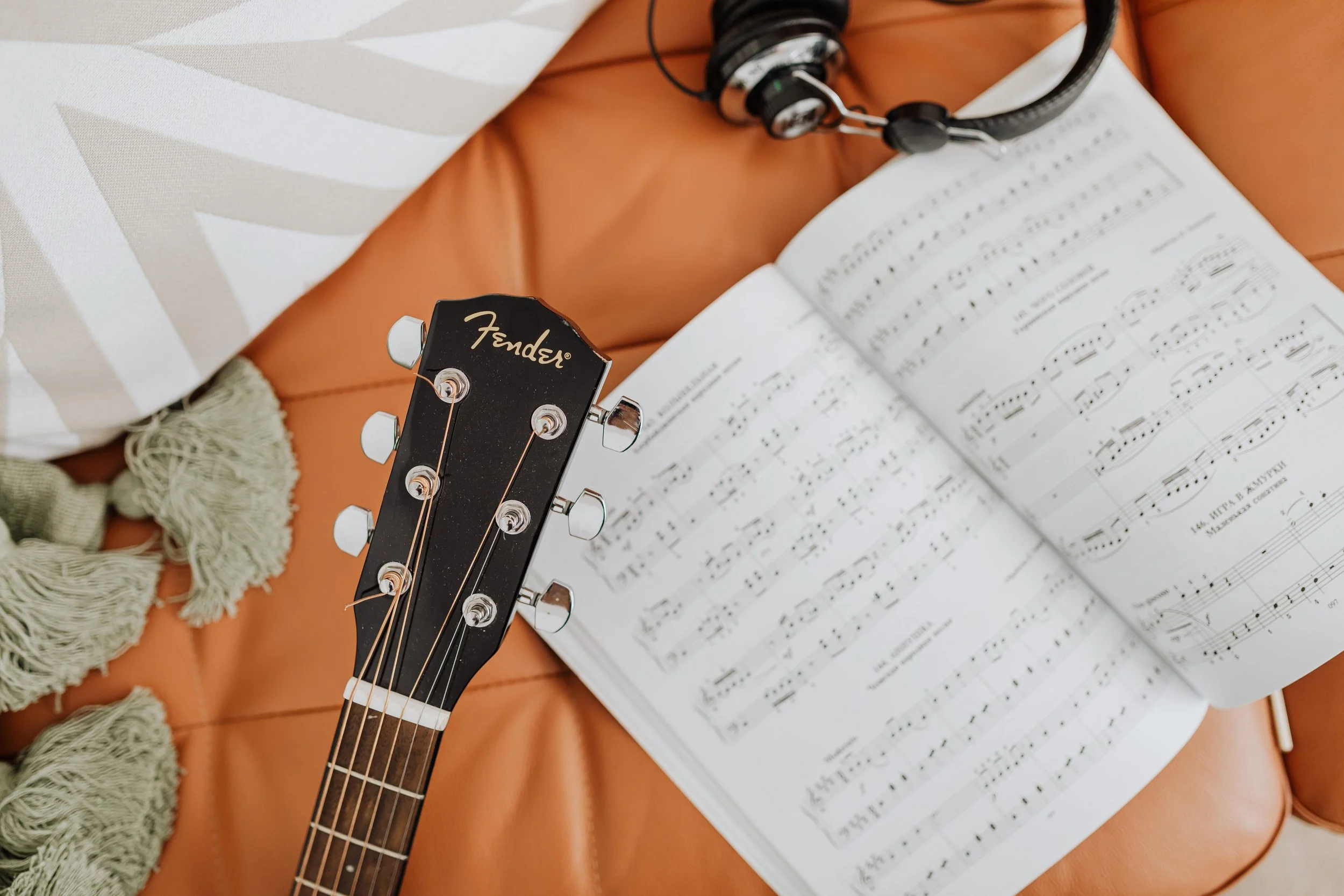Music For Kiddos Podcast
Listen on: Apple Podcasts | Spotify | Amazon Music | Stitcher
We are continuing our songwriting series on the blog and on the Music For Kiddos Podcast. If you haven’t read the first blog post or if you haven’t listened to the first episode introducing the Songwriting 101 series titled Songwriting 101: Song Form, please go read or listen to that one before you dive into part 2 (this blog post) because they very much go hand in hand and will give you a baseline of information that you need as far as chord progressions go.
We're going to talk about chord progressions today, and we're going to keep it pretty basic and look at it as a theory approach and a song form approach. When you think about things like chord progressions, and you put on your songwriter lens, you talk about things differently from the songwriting perspective than you do if you were just analyzing it from a theory perspective. We're gonna look at the theory and take a look at the concepts, but keep those very basic.
My goal with this is that you feel confident to write a song and actually use it in a functional way.
When you think about a chord progression, first of all, you are determining the harmony for the whole entire song. A melody can give you a very good idea of what the harmony is going to be, but sometimes, you can sing one note in the melody and it can suggest a couple of different chords in the harmony. You could also go “out of the box” and do a dissonant melody, and then your harmony and chord progression can be quite different, but when you're selecting a chord progression, you are selecting the harmony for the whole entire song. So, it's very important that the harmony reinforces the melody, that it provides a foundation for the melody, that makes a lot of sense for the melody and supports it in the way that you want to.
There's all kinds of things in there like the mood of the song, the groove of the song and then of course, the lyrics which reinforce your melody, and the melody which might be reinforced by the chord progression, etc. If you can get all of these things (your melody, your harmony, your groove, your baseline, etc.) in sync through your lyrics, then your song is going to feel much stronger.
In sum, your chord progression is vital to the organization and the structure of the song but it doesn't have to be complicated. In fact, in a lot of cases, the less complicated it is, the more it makes sense to people neurologically.
Before we dive in…
…a disclaimer, because I feel I often need disclaimers when I'm talking about music, because I'm talking about it from my very narrow perspective. I grew up in the United States. I listened to primarily pop rock, folk music, some classical music growing up and in college. I studied primarily very westernized, Americanized contemporary music, so I'm going to go ahead and say that my perspective of chord progressions, song form, and songwriting very much falls in that narrow category of westernized, Americanized rock pop, folk genres.
The beautiful thing, as we know about music, is that there are no actual rules. What a beautiful thing it is that I can go across the world and sit in somebody else's home and they can have a completely different understanding of things like song form and chord progression, meter and an overall different understanding of music.
A theoretical perspective: I, IV, V chord progression
I like to talk about chord progressions in numbers. For example, a I, IV, V chord progression.
So I, IV and V chords are major on a major scale. II, III, and VI are minor, and your VII chord is a diminished chord (but we’re going to skip this chord because it's not very helpful in a lot of songs until you get to jazz and other styles, which we are not covering today).
Let's look at I, IV and V, the major chords.
Those are our most commonly used chords in a key, and it kind of makes sense cause they're the major chords. If you think about “Twinkle, Twinkle Little Star”, the “ABC's”, “You Are My Sunshine”, all of these nursery rhymes have this simplistic sound to it. A lot of the songs you hear on the radio also feature I, IV and V. Sometimes they throw in a minor VI chord or a minor II chord, but generally speaking, they are within that general structure (I, IV, V).
Now, let's look at a I, IV, V chord progression and how it might work on top of a standard song form. The nice thing about this chord progression is that we can write a song with I, IV, V chords and they can be used in any order. Maybe your chorus is the part of the song that features the I chord a lot. If that's the case, then your verse might start with a IV chord because that gives it a little bit of a different flavor and that can be your whole entire song (the chorus starting on the I and the verse starting on the IV chord). If you wanted to add in a bridge off of that early basic chord structure, you would probably add a minor VI and then go back to your chorus.
A theoretical perspective: blues
Basically, a Blues is a I, IV, V chord progression with a little extra added: I, IV7 and V7 and what a huge difference that makes! right. It sounds very distinctive and clear when it is a Blues.
A theoretical perspective: minor key
Let's go ahead and take the same concept of I, IV, V, but apply it in one other way.
And that is going to be to put it in a minor key. Suddenly, we would have a I chord that is minor, a IV chord that is minor and a V chord that is major. In the key of A minor, for example, it would be A minor (I) D minor (IV), and E major (V), which is a very common chord progression, on piano, on guitar, etc. We are still doing a I, IV, V but it's minor.
If you’d like to continue to dive deeper on this topic…
There's a lot of ways that you can utilize these chord progressions and change them around. If you’d like to dive deeper on this topic of chord progressions when it comes to songwriting, I invite you to listen to episode 56 of the Music For Kiddos Podcast.
What I want to remind you of is that it doesn't have to be complicated. I think sometimes we're searching for new chord progressions, but sometimes we forget some other tricks too— I say this because I do this too. For example, if you're sitting down at the guitar to write a song and you like to play in the key of G, maybe you don't realize that pretty much every time you're playing the key of G you're playing it for four beats; what would happen if you played it for six beats and then put another chord in there for the rest of the measure? What would happen if you changed your groove and your strum pattern? What would happen if you put a capo on your guitar and you put it up to the fifth fret?
There's all these different tricks that you can use to help you create new songs using the same concepts, but in a new way.
We have partnered with West Music to offer free shipping on orders above $59.95 to Music For Kiddos Podcast’s listeners. Check out their incredible instruments and their incredible offerings at WestMusic.com or you can place your order at their customer service hotline at (800) 397-9378.
The code for free shipping is KIDDOS25. Make sure to check them out!
We've also partnered with Bear Paw Creek, who creates some of my favorite movement props for my music classes and music therapy sessions. Check them out at www.musicandmovementproducts.com
LET’S KEEP IN TOUCH!
Song-of-the-Month Club (FREE!)
THANKS FOR TUNING IN TO THE MUSIC FOR KIDDOS PODCAST!
Thanks for joining us on the Music for Kiddos podcast! If you enjoyed this episode, please head over to Apple Podcasts and tell us what you think by leaving a review! Don’t forget to sign up for the Song-of-the-Month-Club to receive a free, high-quality original song every month, or hang out with us on Instagram to stay connected.



